

Using a stick floatWhere did the stick float come from? It is doubtful that any swim on a river has an even depth and that the current flow is uniform or that it flows in only one direction. For these reasons competition anglers have developed a method that can be used to search the water for fish. 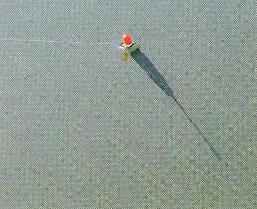
Through its correct use you can present a bait at various depths. You can let it run through at the speed of the current and you can hold it back very hard and it won�t go under. This is because unlike a waggler it is attached to the line at the top and bottom. Also because of its design it can register bites on the drop. All this makes it an extremely versatile item to have and to master. Stick floats basically have light shotting capacities � only up to about 4BB. They are mostly used with small baits such as maggots and casters at close range (up to, say, three rod lengths out) in steady water of moderate depth � up to around 2.5m (8feet). How Do They Work?
The Right Technique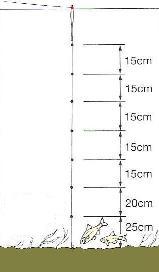 To fish correctly you have to present your hookbait in a manner suitable to a feeding fish. Whether running through, holding back or fishing on the drop, there are certain things to aim for and other things to avoid.
To fish correctly you have to present your hookbait in a manner suitable to a feeding fish. Whether running through, holding back or fishing on the drop, there are certain things to aim for and other things to avoid.
Never use a float that is bigger than necessary. As a guide, for swims of 1-1.2m (3-4ft) deep use a 4 no.4 float. For swims of 1.5-2.5m (5-8ft) deep use a 5 no.4 float. For swims of 2.7-3.7m (9-12ft) deep use a 6 or 8 no.4 float. Don't forget about the pace of the swim, this will also affect your choice � for faster swims use a heavier float. If the swim is over 4.3m (14ff) deep, use a different method. How Do You Fish It?There are 4 methods when fishing a stick, although the adept fisherman can blend these methods to fit the conditions on the day.  Running through at the speed of the flow is probably the most natural way of fishing a stick. This can be a very effective method in the summer when the fish are moving about. Your bait should touch bottom or run through several inches off, so accurate plumbing is essential.
Running through at the speed of the flow is probably the most natural way of fishing a stick. This can be a very effective method in the summer when the fish are moving about. Your bait should touch bottom or run through several inches off, so accurate plumbing is essential.
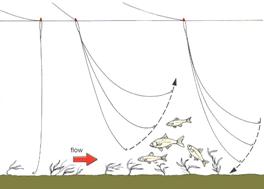 The next method is the lift and drop, sometimes called making the bait dance. You can sometimes entice fish by making the bait rise and fall as it travels through the swim. Do this by setting your float to the depth of the swim and lightly shotting the bottom 60cm- 1 .8m (2- 6ft). Checking the float every few metres down your swim and then letting it run through causes the bait to rise and fall. How often you do this and the amount of time you hold back depend upon the flow and the way the fish are feeding. The key to success is to experiment.
The next method is the lift and drop, sometimes called making the bait dance. You can sometimes entice fish by making the bait rise and fall as it travels through the swim. Do this by setting your float to the depth of the swim and lightly shotting the bottom 60cm- 1 .8m (2- 6ft). Checking the float every few metres down your swim and then letting it run through causes the bait to rise and fall. How often you do this and the amount of time you hold back depend upon the flow and the way the fish are feeding. The key to success is to experiment.
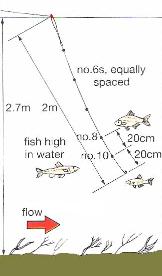 The third method is On the drop. You want to use this method when the fish are feeding in mid-water, under your loose feed. Fish this rig off the bottom and shot it lightly so that the bait falls slowly through the feed zone. By casting so that the shot lands in a straight line downstream of the float, the bait sinks in a smooth arc. The float gradually rights itself as the bait sinks, and is able to register a fish intercepting the bait on the drop.
The third method is On the drop. You want to use this method when the fish are feeding in mid-water, under your loose feed. Fish this rig off the bottom and shot it lightly so that the bait falls slowly through the feed zone. By casting so that the shot lands in a straight line downstream of the float, the bait sinks in a smooth arc. The float gradually rights itself as the bait sinks, and is able to register a fish intercepting the bait on the drop.
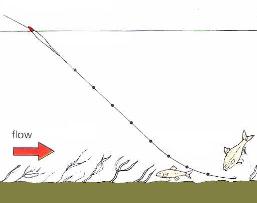 The final method is holding back. Try this method When the water temperature is low, constant holding back often scores. By setting the float 15-45cm (6-l8in) overdepth, and inching it through the swim, you can steer the bait into the fishes� mouths. You may only need to fish one or two rod lengths out.
The final method is holding back. Try this method When the water temperature is low, constant holding back often scores. By setting the float 15-45cm (6-l8in) overdepth, and inching it through the swim, you can steer the bait into the fishes� mouths. You may only need to fish one or two rod lengths out.I hope this helps you in your quest to catch fish. If it does or if you know something I have left out, please take the time to drop me a message through the Contact Us page and I will put it in. Thanks and tight lines  Custom Search Back to Stick Float Top Back to Fishing Rigs Back to Home |























